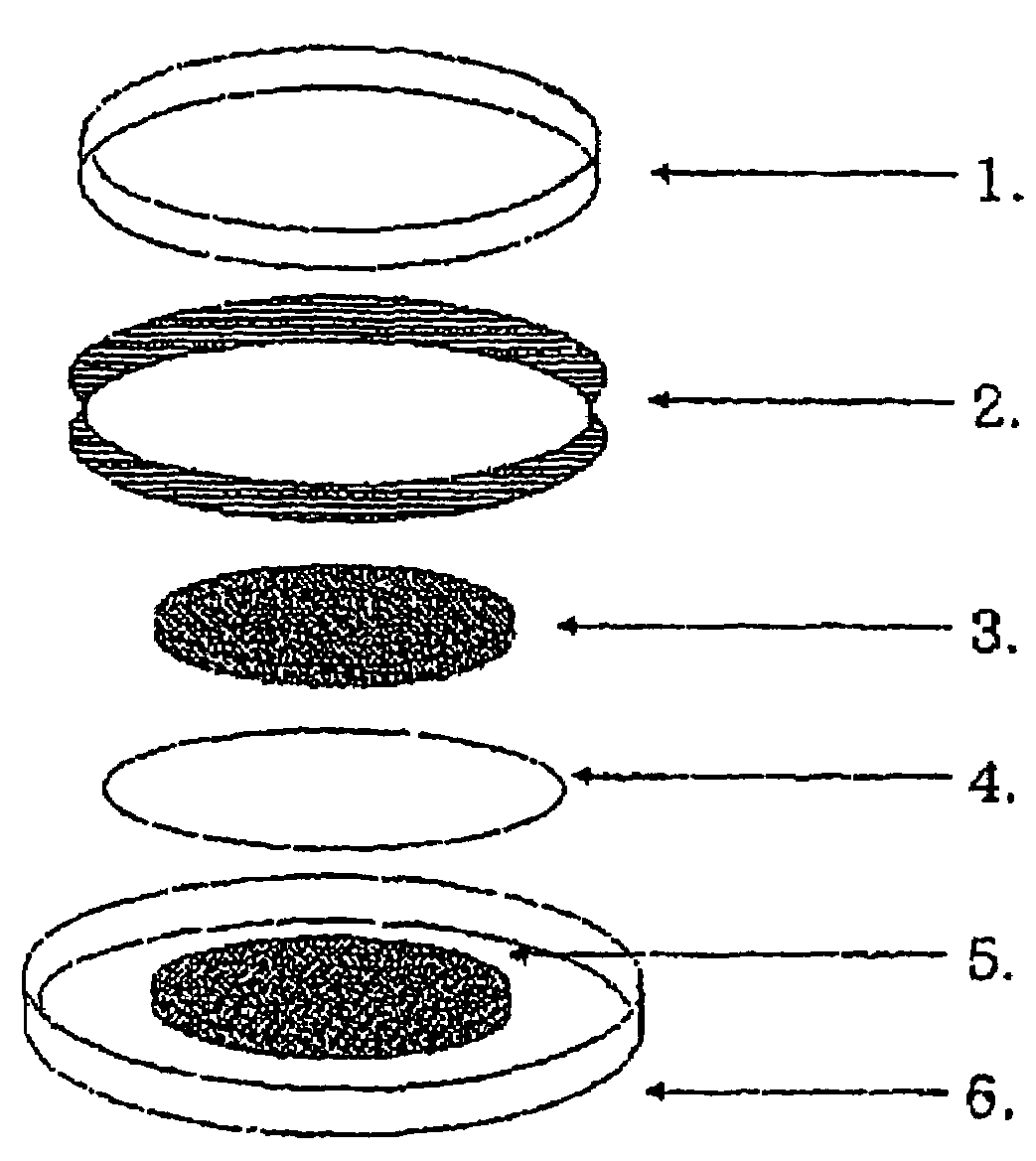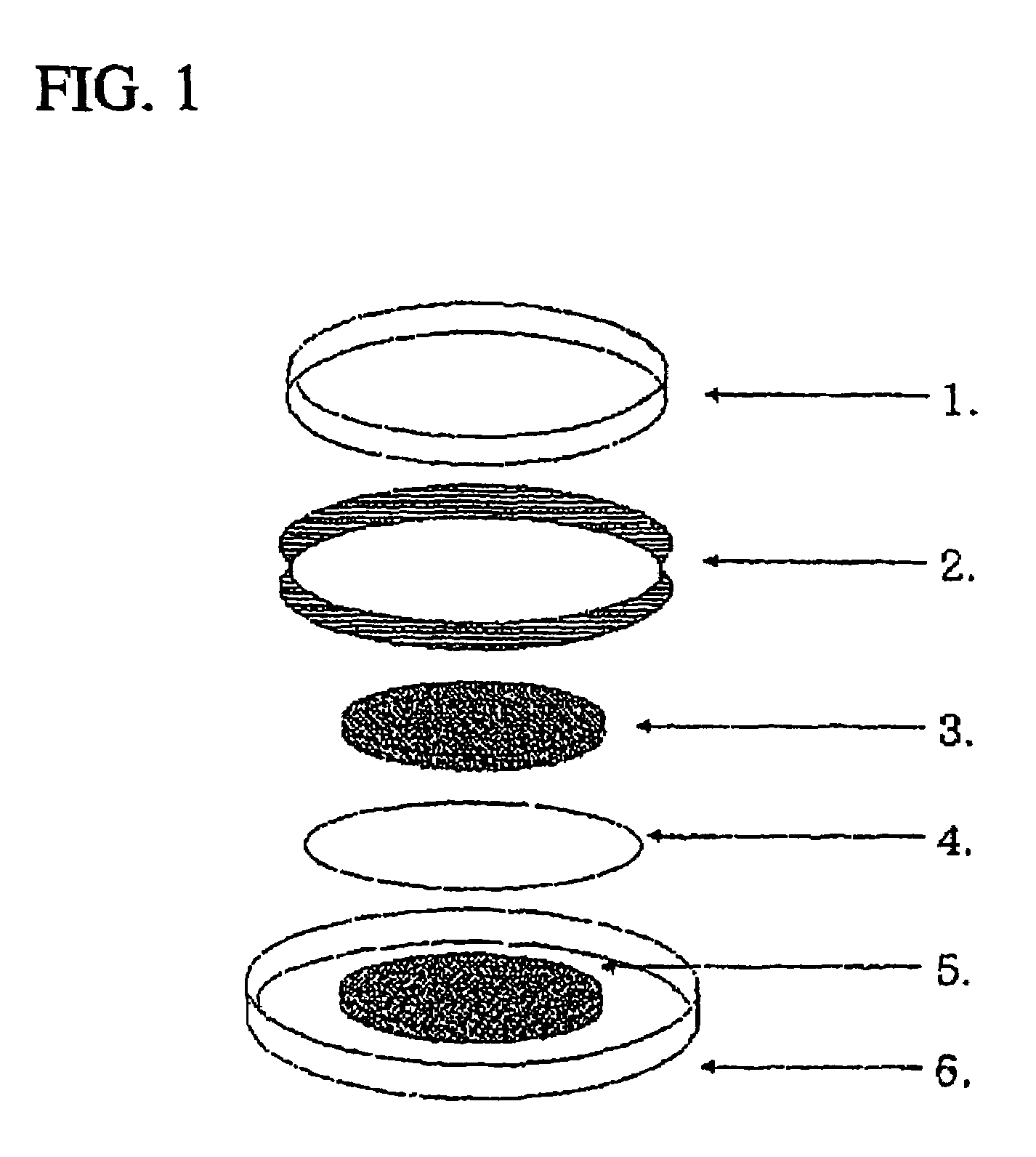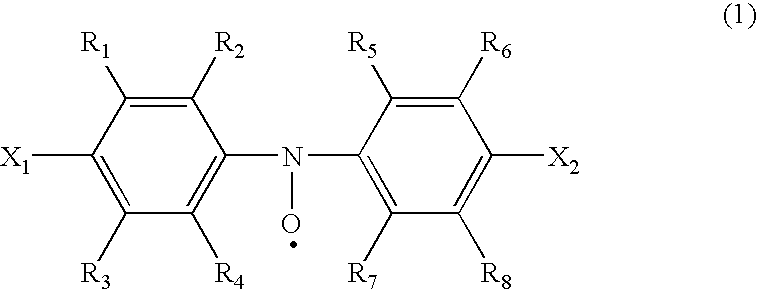Secondary battery having an active material radical compound
a radical compound and active material technology, applied in the field of secondary batteries, can solve the problems of insufficient capacity per unit mass of batteries, reduced capacity, and increased energy consumption of batteries, and achieves superior cyclic performance, reduced active materials, and increased energy density.
- Summary
- Abstract
- Description
- Claims
- Application Information
AI Technical Summary
Benefits of technology
Problems solved by technology
Method used
Image
Examples
embodiment 1
[0032]In accordance with the present invention, a compound represented by the formula (1) may be used as an active material.
[0033]
[0034]In the formula (1), X1 and X2 may be identical with or different from each other, and represent a group represented by the formula (3), (in which R10 represents alkyl group or substituted or unsubstituted phenyl group), alkoxyl group, halogen atom, hydroxyl group or cyano group, and R1˜R8 each independently represent hydrogen atom or alkyl group. X1 and X2, for example, represent ternary alkyl groups such as tert-butyl group, 1,14-dimethylpropyl group, 1,1-dimethylbutyl group, 1,1-dimethylpentyl group, 1,1-dimethylhexyl group, and 1,1-dimethylheptyl group; phenyl-group-substituted ternary alkyl groups such as 2-(2-phenyl)propyl group, 2-(2-tryl)propyl group, as 2-(2-fluorophenyl)propyl group, 2-(2-chlorophenyl)propyl group, 2-(2-bromophenyl)propyl group, and 2-(2-iodophenyl)propyl group; alkoxyl groups such as methoxyl group, ethoxyl group, propoxyl...
example 1
[0069]50 mg of a compound (A) having a structure represented by the below formula (A), 200 mg of graphite powders, and 25 mg of polytetrafluoroethylene resin binder were determined and admixed by using an agate mortar. A mixture was obtained by drying and admixture for about 10 minutes. The mixture was then extruded by a roller under a pressure to form a thin film with a thickness of about 200 micrometers. This thin film was dried at 80° C. in a vacuum through one night, before punching the same to form a circle with a diameter of 12 millimeters, thereby forming a coin-shaped electrode for battery.
[0070]The obtained electrode was dipped into an electrolytic solution so that the electrolytic solution was impregnated into gaps in the electrode. As the electrolytic solution, there was used a mixture solution of ethylene carbonate and diethylcarbonate including 1 mol / l of an electrolyte salt LiN(C2F5SO2)2 (a mixing ratio of ethylene carbonate and diethylcarbonate is 3:7). The electrode ...
example 2
[0073]An electrode for a coin-shaped battery was prepared in the same manners as in Example 1, provided that 25 mg of a compound (B) having a structure represented by the below formula (B) was used instead of the compound (A). A sealed coin-shaped battery with this electrode was assembled in the same manners as in Example 1, provided that a mixture solution of ethylene carbonate and diethylcarbonate including 1 mol / l of an electrolyte salt LiN(C2F5SO2)2 (a mixing ratio of ethylene carbonate and diethylcarbonate is 3:7) was used together with the separator, the positive electrode collector, the negative electrode (lithium metal) and the negative electrode collector.
[0074]The battery, which has the compound (B) prepared described above as the positive electrode active material and the lithium metal as the negative electrode active material, was charged up at a constant current of 0.1 mA so as to have a voltage of 4.0V. Subsequently, a discharge of the battery was made at a constant cu...
PUM
| Property | Measurement | Unit |
|---|---|---|
| thickness | aaaaa | aaaaa |
| diameter | aaaaa | aaaaa |
| voltage | aaaaa | aaaaa |
Abstract
Description
Claims
Application Information
 Login to View More
Login to View More - R&D
- Intellectual Property
- Life Sciences
- Materials
- Tech Scout
- Unparalleled Data Quality
- Higher Quality Content
- 60% Fewer Hallucinations
Browse by: Latest US Patents, China's latest patents, Technical Efficacy Thesaurus, Application Domain, Technology Topic, Popular Technical Reports.
© 2025 PatSnap. All rights reserved.Legal|Privacy policy|Modern Slavery Act Transparency Statement|Sitemap|About US| Contact US: help@patsnap.com



